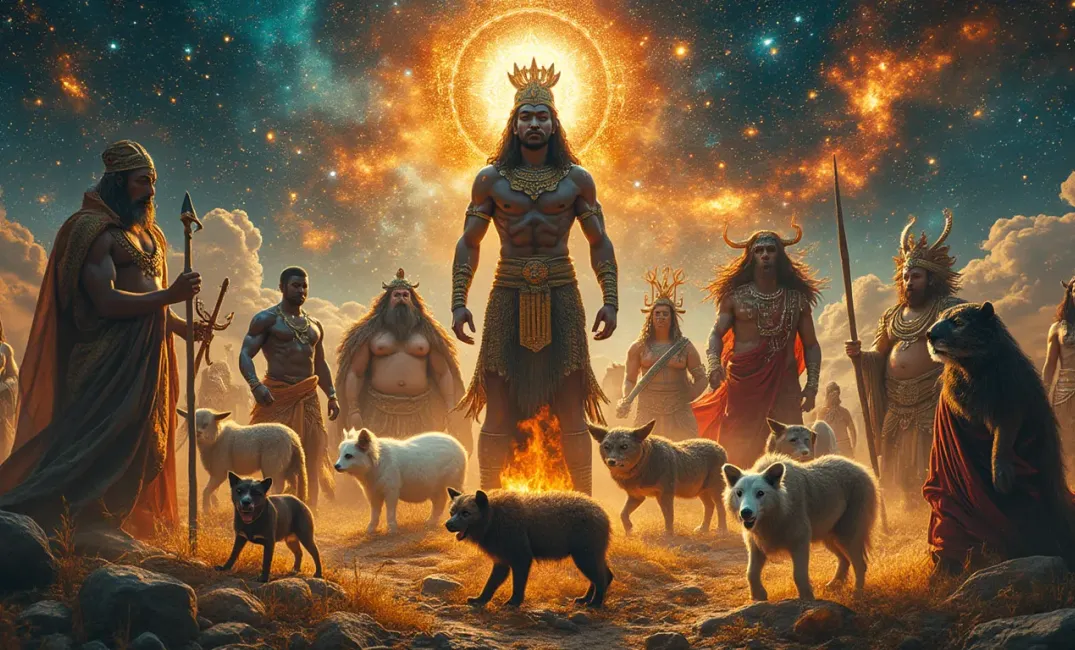Introduction: The Power of Myth and Legend
Myths and legends are the vivid tapestry of human imagination, reflecting the collective psyche of civilizations across time. These narratives—echoes from the whispers of ancestors—bear the weight of cultural identity, moral lessons, and cosmic understanding. Through their timeless resonance, they have guided human behavior, shaped spiritual beliefs, and inspired artistic and literary endeavors. This exploration delves into the rich tradition of myths and legends worldwide, examining their role in shaping cultures, connecting generations, and infusing everyday life with meaning and narrative.
The Nature of Myths: Foundations of Belief
Creation Myths: Crafting the Cosmos
- Genesis of Worlds: Varied narratives across cultures address creation, offering answers to existential questions. For instance, the Aztec creation myth describes cosmic cycles resulting in humanity's emergence, while the Yoruba creation story speaks of life crafted by the divine spirit Ọbatala from clay.
- Symbolism and Meaning: Creation stories often embody profound symbolism. The Norse Yggdrasil, the world tree, represents interconnected realms, emphasizing nature's unity. These epics reflect humanity's awe of nature and the cosmos.
The Pantheon of Gods and Heroes
- Deities and the Divine: Mythologies elevate human experiences to celestial realms, humanizing gods with frailties and virtues. The Greek pantheon, with Zeus and Athena, parallels societal roles and power dynamics.
- Heroes and Adventures: Heroes, from Gilgamesh to King Arthur, embody human aspirations and virtues. Their quests—epic journeys of valor, betrayal, and triumph—mirror personal and societal challenges, promoting moral principles and cultural ideals.
Legends: Bridges Between Past and Present
Historical Legends: Fact and Fiction Interwoven
- Cultural Heritage: Legends like those of Robin Hood or the Last Emperor in China deftly intertwine reality with imagination, preserving historical events within the cultural memory, simultaneously endorsing societal ideals like justice and resistance.
- Personification of Place: Legends often personify landscapes, rendering them sacred. The Aboriginal Dreamtime recounts ancestral beings shaping Australia, instilling geographical features with spiritual significance and guiding ecological stewardship.
Moral Parables and Lessons
- Tales with Morality: Legends often serve as a vehicle for conveying ethical teachings. The trickster archetype ubiquitous in African, Native American, and Asian stories—like Anansi the Spider or the Scorpion and the Frog—impart lessons about human nature and morality through cunning and mischief.
- Cultural Values and Warnings: Warnings embedded in legends, such as the Greek myth of Icarus or the haunting Irish legend of the Banshee, reinforce societal values, instilling humility, respect, and reverence for the supernatural.
Cultural Significance: Shared Narratives and Identity
Embodiments of Cultural Identity
- Rituals and Celebrations: Myths come to life through rituals—ceremonial reenactments that breathe vitality into narratives. The Hindu festival of Diwali, rooted in the myth of Lord Rama's triumph, reinforces communal bonds through shared celebration.
- Symbols of Identity: Iconic symbols derive their potency from myths, embodying cultural identity. From the Native American Thunderbird to Japan's Amaterasu, such symbols solidify communal perspectives, offering continuity amidst change.
Interwoven Global Tapestry
- Cultural Parallels: While distinct, myths worldwide reveal universal themes. The Flood myth, appearing in Mesopotamian, Indian, and Inca traditions, echoes humanity's collective fears and yearnings, showcasing our shared quest for understanding.
- Cross-Cultural Influences: Trade, conquest, and migration facilitated myth adaptation and exchange. The syncretic mythologies of the Caribbean, combining African, Indigenous, and European elements, testify to cultural resilience and interconnectedness.
Evolution of Myths in Contemporary Society
Modern Retellings and Adaptations
- Literary Inspirations: Contemporary literature draws heavily from ancient myths, reimagining narratives to reflect modern sensibilities. Works like J.R.R. Tolkien’s "The Lord of the Rings" and the "Harry Potter" series infuse mythical archetypes within new worlds, fostering enduring connections with mythical themes.
- Film and Media Adaptations: Cinematic retellings bring mythological epics like Hercules or King Arthur to life for mass audiences. These adaptations reflect cultural nostalgia and modern reinterpretation, reviving myths in visual formats.
The Digital Realm of Mythology
- Online Extensions: Digital platforms democratize myth narration, allowing communities to share regional tales globally. Websites, podcasts, and forums engage audiences in myth discussion, preserving narratives for future generations.
- Interactive Storytelling: Video games like "God of War" or "Assassin's Creed" embolden mythological engagement through interactivity, transforming passive narrative consumption into participatory encounters.
Myths and the Human Psyche
Resolution of Inner Conflict
- Uncovering Archetypes: Myths elucidate collective unconscious processes, as explained by Carl Jung. Archetypal figures—like the hero, mentor, or shadow—reflect inner struggles and aspirations, offering tools for psychological insight and personal growth.
- Cultural Perceptions of Afterlife: Myths explore existential themes like life and death, providing solace and perspective. The Egyptian Duat or the Odyssey's journey to the Underworld affirm cultural perceptions of the afterlife, framing death as a transformative passage rather than an end.
Catalysts for Transformation
- Narratives of Change: Myths exemplify transformation and renewal, inspiring personal and societal change. The Phoenix rising from ashes symbolizes rebirth, suggesting resilience through adversity and continual evolution.
- Symbolic Exploration of Modern Challenges: Myths serve as metaphors for contemporary struggles. Environmentalist narratives parallel Earth-goddess myths, emphasizing nature's sanctity and humanity’s stewardship responsibilities.
Conclusion: The Eternal Dance of Myth and Identity
Myths and legends resonate as eternal threads woven into the fabric of human experience. They are whispered myths and echoed legends that cradle humanity's oldest teachings, anchoring societies amid ceaseless change. By perpetuating shared stories, communities preserve the ethos of past civilizations while envisioning new horizons.
As modernity catapults the shifting dynamics of human society, myths remain steadfast pillars of spiritual vigor and inspiration. Their timeless resonance will likely continue shaping generations yet unborn, imbuing them with cultural wisdom, fundamental truths, and the boundless creativity that lies at the heart of human imagination.
"In every myth lies a nugget of truth, for they are the narratives by which humanity comprehends its past, dreams of the future, and weaves the fabric of its cultural tapestry." — *Author Unknown*
HISTORY, CREATION, STORYTELLING, CULTURE, MYTHS, LEGENDS, HEROES, GLOBAL IDENTITY

